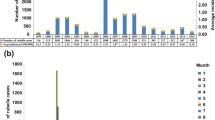Abstract
In order to ascertain the epidemiology of rubella infections in Austria, a seroepidemiological study was performed. Data collected from 115 cases diagnosed at the Institute of Hygiene and Social Medicine of the University of Innsbruck during 2001 were evaluated. The results indicate this infection can no longer be categorised as a paediatric disease (mean age, 18.5 years), and several other findings were particularly striking: (i) 47% of the patients had elevated C-reactive protein levels and 50% had increased anti-streptolysin O titres; (ii) only a few patients complained of fever, while symptoms such as rash and lymphadenopathy, which are also associated with several other viral infections, including HIV, were found frequently; and (iii) the 115 rubella cases detected in the 1-year study period represented an incidence of >13 per 100,000 population. This high incidence of infection underlines the need for further improvement of diagnostic tests and more successful vaccine strategies.
Similar content being viewed by others
References
Reef SE, Frey TK, Theall K, Abernathy E, Burnett CL, Icenogle J, McCauley MM, Wharton M (2002) The changing epidemiology of rubella in the 1990s: on the verge of elimination and new challenges for control and prevention. JAMA 287:464–472
WHO position paper (2000) Rubella vaccines. Wkly Epidemiol Rec 75:161–169
Hermann KL (1985) Available rubella serological tests. Rev Infect Dis 7:108–112
Pedneault L, Zrein M, Robillard L, Landry F, Lacroix M, Joncas J (1994) Comparison of novel synthetic peptide-based DETECT-RUBELLA enzyme immunoassays with Enzygnost and IMx for detection of rubella-specific immunoglobulin G. J Clin Microbiol 32:1085–1087
Gießauf A, Letschka T, Walder G, Dierich MP, Wuerzner R (2004) A synthetic peptide ELISA for the screening of rubella virus neutralizing antibodies in order to ascertain immunity. J Immunol Methods 287:1–11
Zrein M, Joncas JH, Pedneault L, Robillard L, Dwyer RJ, Lacroix M (1993) Comparison of a whole-virus enzyme immunoassay (EIA) with a peptide-based EIA for detecting rubella virus immunoglobulin G antibodies following rubella vaccination. J Clin Microbiol 31:1521–1524
Mitchell LA, Zhang T, Ho M, Decarie D, Tingle AJ, Zrein M, Lacroix M (1992) Characterization of rubella virus-specific antibody responses by using a new synthetic peptide-based enzyme-linked immunosorbent assay. J Clin Microbiol 30:1841–1847
Smith CA, Petty RE, Tingle AJ (1987) Rubella virus and arthritis. Rheum Dis Clin North Am 13:265–274
Ozsoylu S, Kanra G, Savas G (1797) Thrombocytopenic purpura related to rubella infection. Pediatrics 62:567–569
Hecht FM, Busch MP, Rawal B, Webb M, Rosenberg E, Swanson M, Chesney M, Anderson J, Levy J, Kahn JO (2002) Use of laboratory tests and clinical symptoms for identification of primary HIV infection. AIDS 16:1119–1129
Kahn JO, Walker BD (1998) Acute human immunodeficiency virus type 1 infection. N Engl J Med 339:33–39
Enders G (1991) Infektionen und Impfungen in der Schwangerschaft. Urban& Schwarzenberg, Munich, pp 9–36
Health Advisory Board to the Austrian Government (Oberster Sanitätsrat) (2003) Impfplan für 2004 für Österreich http://www.bmgf.gv.at/cms/site/attachments/1/4/0/CH0016/CMS1038913010412/impfplan_2004.pdf
Ringler M, Gobel G, Most J, Weithaler K (2003) Fully vaccinated children are rare: immunization coverage and seroprevalence in Austrian school children. Eur J Epidemiol 18:161–170
Taylor B, Miller E, Lingam R, Andrews N, Simmons A, Stowe J (2002) Measles, mumps, and rubella vaccination and bowel problems or developmental regression in children with autism: population study. BMJ 324:393–396
Acknowledgements
We wish to thank the medical technical assistants from the virological–serological laboratory for their support in performing ELISAs and hemagglutination inhibition tests. Further, we thank the participating doctors and their patients for their cooperation. Special thanks go to Dr M. Sarcletti, Innsbruck, for his input concerning the differential diagnosis of HIV and to S. Falkensammer for secretarial support.
Author information
Authors and Affiliations
Corresponding author
Rights and permissions
About this article
Cite this article
Falkensammer, B., Walder, G., Busch, D. et al. Epidemiology of rubella infections in Austria: important lessons to be learned. Eur J Clin Microbiol Infect Dis 23, 502–505 (2004). https://doi.org/10.1007/s10096-004-1138-0
Published:
Issue Date:
DOI: https://doi.org/10.1007/s10096-004-1138-0




